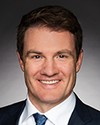Thank you.
Certainly we are concerned about competition, and of course as Conservatives we always believe in the free market, but we are particularly moved today by the advance news that it looks as though the European Union will not be moving to approve this transaction, and we are concerned that it would be moot at this point.
It's one of the three necessary components for the transaction to go through. If, as we have heard, that the European Union is not going to approve it, then it would seem to us that it is not a good use of time to spend time on something that appears inevitably will not occur. Therefore, we will not be supporting this motion at this time.




